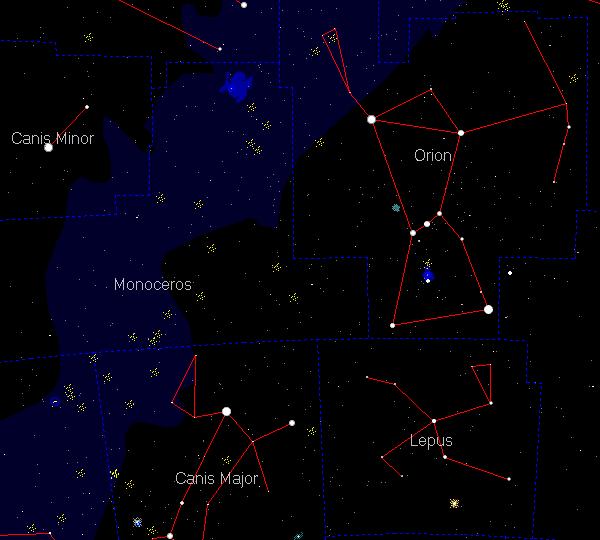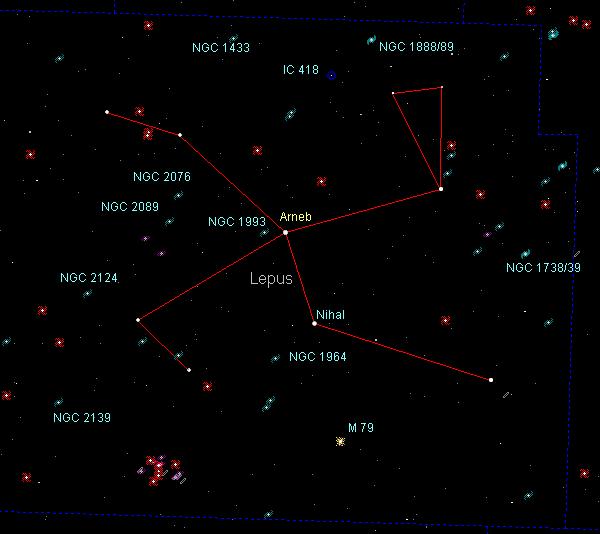Chasing the Hare
The night sky is a theatrical stage of mythological characters, unique stories of how the interaction with others. Amongst the wintry constellations is Lepus the Hare. Although Orion the Hunter is poised in battle with Taurus the Bull, he also liked to hunt our long-eared friend.
Lepus is located directly below Orion and appears as a crooked cross of stars. Its members shine between third and fourth magnitudes. In area, Lepus takes up only 290 square degrees of sky – putting it in 51st position.
At the center of the asterism is magnitude 2.6 Alpha Leopris aka Arneb. Located an estimated 1,280 light-years from the Sun Arneb is a class F supergiant star that would extend close to the orbit of Mercury if it replaced our Sun. Arneb’s temperature lists at 7,000 degrees Kelvin and given its size, is some 13,000 times brighter than the Sun.

Just below Arneb is the Beta star called Nihal - a class G star like our Sun and shines a tad dimmer than Arneb at magnitude 3.1. This star has a companion only 2.5 arc seconds away. In fact, its magnitude has been observed to shift from seventh to eleventh, meaning it could be an eclipsing double. Nihal is 160 light-years from us.
The Spirograph Nebula, cataloged as IC 418, is located about 2,000 light-years away. It was on the list of objects for the Hubble Space Telescope to investigate. Only through the perfect eyes of the Hubble does the inner structure of this planetary nebula reveal itself. The fine woven detail is incredible and well deserves its name.
Astronomers are still trying to understand this internal, complex pattern. Only a few thousand years ago, this planetary was a Sun-like star, shining with the rest in the night sky. However, as its valuable fuel was consumed, it became a red giant and eventually transformed into this amazing portrait that measures a third of a light-year across itself. The remaining central neutron star is at magnitude 10.2 whereas the entire planetary is around 12th.

The only Messier object to reside within the constellation’s boundaries is M79. Other than the fact, this cluster lies some 40,000 light-years from us; it resides opposite the center of our Milky Way Galaxy. Globular clusters tend to live around a galaxy’s nucleus like flies around a street light. By measuring its distance, astronomers calculate M79 is about 120 light-years wide. At magnitude 7.7, this target can be located with simple binoculars.
| Object | Type | Magnitude | R.A. | Dec. |
|---|---|---|---|---|
| IC 418 | Planetary nebula | 12.0 | 05h 27m 30s | -12d 42s |
| M 79 | Globular cluster | 7.7 | 05h 24m 30s | -24d 33s |
| NGC 1738/39 | Galaxies | 13.0 | 05h 01m 42s | -18d 11s |
| NGC 1964 | Galaxy | 10.8 | 05h 33m 24s | -21d 57s |
If you are up to a bit of a challenge, I suggest NGC 1738 and 1739. These two seem to be overlapping together. NGC 1738 (the brighter of the two) is about 13th magnitude and the two occupy about an arc minute of sky.
The premiere galaxy belonging to Lepus is NGC 1964. This magnitude 10.8 spiral measures a bit more than six arc minutes long or a fifth of the full moon’s width. It has a delicate spiral arm structure and is a great target for astrophotography. To find NGC 1964, relocate Nihal that mentioned earlier in the article and move almost one and a half degrees southeast.
Mars is now visible all night long as it rises at sunset at the beginning of the month. At first glance through a telescope, the 14 arc-second disk will reveal a dazzling, white north polar cap. At the south end is dark Mare Tyrrhenum. Good seeing will reward you in surface detail. Although this perihelion (closest approach) was nowhere near the 2003 approach, you should still give the red planet a chance.
Since Earth is closer to the Sun than Mars, we orbit quicker and are now overtaking Mars in the race. All this month you will notice Mars is moving westward (retrograde). On March 10th Mars will appear to stop this motion (stationary) and start moving eastward as our worlds keep separating. Our next perihelion will occur in March of 2012 but our distance will be 100 million kilometres, a million more than this event. The best show will be in July 2018 when the disk will be a respectable 24 arcseconds wide and our distance a lot shorter.
Saturn is now visible on the eastern horizon at 11 p.m. local time on the first of the month, 10 p.m. mid-month and 9 p.m. at month’s end. The marvellous rings are slowly coming out of its September 2009 edge-on view. The ring system is now inclined to four degrees. On the early morning of February 3rd, Saturn will be nine and a half degrees north of the Gibbous Moon.
For those living on the east coast, try spotting the very thin 19 hour Moon on Valentine’s Day night, and 23 hour Moon on the west coast. Be sure to also follow Venus and it scoots by Jupiter low in the west on the 15th, 16th and 17th. The two will be separated by about a full moon’s width on the 15th, so get those cameras ready. The full Snow Moon will occur on the last day of February.
Until next month, clear skies everyone.
